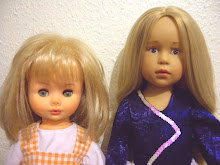My 8 year old daughter was given this kit for her birthday. It is more complex than the felt doll she sewed for herself and she needed adult help. I decided that because there was a lot of sewing involved this was a good opportunity to start teaching her how to use a sewing machine, however, rather than teach her with the electric machine, and because she had seen an old working sewing machine at Bletchley Park the previous day, I decided my old 1920s Singer could do with some exercise and she was up for the fun.
So for the first time in about 17 years I got the old Singer going again. There is a story attached to this machine, but I'll tell you about that in another post.
 |
| My girl setting up her sewing on the Singer machine, notice the pattern pieces on the sheet |
 |
| Sewing on the Singer machine |
The machine can only stitch ordinary straight running stitch, it cannot stitch backwards or do any fancy patterns. It needed a little adjustment and threading it was an entertainment (fortunately I had left some thread in it so I had some guidance). It seemed to stitch fairly evenly some of the time, then was occasionally uneven, so eventually we changed to my electric machine to complete the kit.
The kit comes with the pieces ready cut, but also with the complete set of pieces printed on a sheet of brown tissue paper for you to match the pieces to it before you start sewing, and this also means you could cut out your own pieces in your own fabric if you wanted to. The pads of the hooves are in a shiny stretchy fabric which is a little tricky to sew. Some of the sewing she did was by hand, using back stitch, however she quickly tired of this in fabric which resisted the needle, which was another reason to use the machine. Most of the fabric is patterned polyester cotton, easy to sew but there were many seams, a daunting task for an inexperienced sewer.
The order of stitching is fairly complex, I don't think she would have managed this kit without the help of an experienced needlewoman. I did a fair bit of the machine sewing, simply because I could sit and reach the foot treadle, whereas she couldn't, however she still took a keen interest in helping put the pony together and helped turn parts right side out and stuff the body parts at various stages. She is delighted with the results (she decided the embroidered nostrils weren't needed) and plays with this little pony quite a lot. The limbs are fastened on with embroidery thread and buttons, so they sort of swivel a bit.
 |
| The completed pony with her box |
 |
| The completed pony, called 'Emily' apparently |

















.jpg)





































































































































2 comments:
I learnt to sew on a crank handle singer sewing machine, but a slighter newer model than you have there. I used it for years and it was great. I was a similar age to your daughter. You can get free manuals online if you don't have one to adjust all the tensions etc...I have quite a collection of antique & vintage singer sewing machines!
The pony looks great, even if it wasn't as easy as hoped.
It does look quite complex, but a lovely end result. I'm fascinated to see this too, after my recent discovery, through a pre-decimal Galt catalogue, that we had even more Galt toys as children than I remembered! I had a look at the current offerings, on their website - great to see one made up. The ones we had were beautifully designed and so strong and longlasting. I hope your daughter gets as much pleasure out of this pony!
Post a Comment